The Great Train Robbery: U.K.'s £2.6 Million Theft
The Great Train Robbery, one of the largest thefts ever in the United Kingdom, occurred on Aug. 8, 1963. The story featured audacious planning, determined detective work, daring escapes, and some details that many people found difficult to believe. In all, 17 men were believed to have played some part in the robbery; some of those men became famous, particularly once they escaped from prison. 
The set of events began the evening before, at 6:50 p.m., when an "Up Special," a traveling Royal Mail train, left Scotland's Glasgow Central Station, bound for London's Euston Station. Powering the 12-carriage train was a diesel-electric locomotive. Onboard sorting the mail during the journey were 72 Post Office staff. Part of the routine was that workers would hang mail sacks on tall hooks standing aside the tracks and onboard workers would exchange their own sorted mail bound for delivery for the sacks hanging on the hooks; this enabled some of the mail to be distributed without requiring the train to stop. Carriage number two behind the engine routinely carried registered mail that needed sorting. This carriage was also the one that often contained large amounts of money. On a normal mail run, this carriage contained as much as £300,000; however, the previous Monday had been a bank holiday, meaning that banks were closed, and so on August 7, the train left Glasgow carrying £2.6 million, in £1 notes, £5 notes, 10-shilling notes, and money from Scotland and Ireland. As well, the carriage containing the money, known as a High Value Packages (HVP) carriage, was supposed to have been equipped with alarms, bars over the windows, and bolts on the doors, as a result of a program instituted in 1961 by the Post Office Investigation Branch. However, the HVP carriage on this particular train on this particular day was one of the older carriages, pressed into service because the ones newly equipped with alarms, bars, and bolts were out of commission and in for repairs. 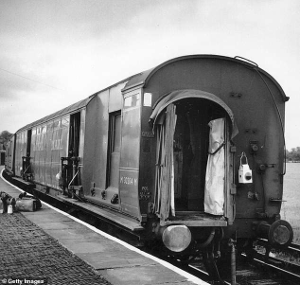
Early on the morning of August 8, a few minutes after 3 a.m., Jack Mills, the driver, stopped the train in Ledburn, at a place known as Sears Crossing, because the signal light was red. What the driver didn't know was that the signal light wasn't really red. A group of men who subsequently robbed the train had covered the green signal light and then connected a battery to the red signal light so it would power up. The other man in the locomotive, secondman David Whitby, left the car and walked to a trackside telephone, to call the railroad person in charge of the signal. When he discovered that the phone wires had been cut, he was the victim of violence: one of the robbers threw him down the embankment. At the same time, more of the gang of robbers stormed the engine and subdued the driver, Mills, eventually striking him a blow with a metal bar that made him nearly unconscious. 
The plan was to move the train half a mile further down the track, to Bridego Bridge, to the spot where a truck and the rest of the gang were waiting. A man later referred to as "Stan Agate" was a train driver who had spent months getting to know his way around the various trains and carriages; however, his experience didn't include driving the particular kind of locomotive that they encountered, and so the gang decided to have Mills drive the train. At this point, both Agate and Ronnie Biggs, whose job it was to supervise Agate's driving of the train, left the locomotive and went to the truck into which the gang planned to place the stolen money. The gang onboard the locomotive enticed Mills to drive the train a bit further down the track, to where a sheet had been dragged across the tracks, and then stop it. Others of the gang tied up or otherwise restrained mail staff in the carriage containing the money. Once the train was stopped, a number of robbers boarded the HVP carriage and removed 120 of the 128 sacks of money. They formed a human chain and took about 20 minutes to make the transfer. Only a half hour after they began their efforts, they left the scene, driving the truck and two other vehicles. A postal worker onboard the train found that all nearby telephone lines had been cut but caught a ride on a passing freight train, traveled a few miles to the nearest town, and sounded the alarm. Soon to be on the case were Buckinghamshire Police Chief Superintendent Malcolm Fewtrell and his staff. Within a few hours, Fewtrell applied to Scotland Yard for help. Detective Superintendent Gerald McArthur and Detective Sergeant John Pritchard went to help Fewtrell's team. In charge of the London investigation at first was Detective Chief Superintendent Tommy Butler, who was named to head the Flying Squad, a branch of London's Metropolitan Police dedicated to investigate commercial robberies. Butler soon formed a new group called the Train Robbery Squad; on that squad were the following:
The robbers had bought Leatherslade Farm, 28 miles away, between Oakley and Brill, two months earlier. They drove there (while listening to news reports of the robbery on their car radios), counted the money, and divided it between each of them, setting aside a few smaller amounts for other people they knew. After hearing further reports suggesting that authorities knew a lot about what happened, they decided so leave the hideout sooner than planned. After acquiring new vehicles because of fears that the getaway vehicles would be recognized, they dispersed at various Helping the police in their investigation was an informant, a prisoner who had heard details of the planned robbery from one of the gang while the latter was also in prison. Police did not identify the informant. 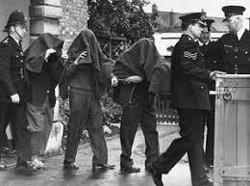
The 11 arrested men were sent to Bedford prison and then Aylesbury prison. They appeared before a judge on Jan. 20, 1964, and all but one entered pleas of not guilty. Cordrey agreed to plead guilty and dutifully returned his share of the money, which turned out to be £80,000. The trial proceeded not long afterward but stalled when prosecutors found evidence that Biggs had a criminal record and the judge removed him for trial at a later date. Train driver Jack Mills took the stand during the monthslong trial, reporting what he saw and remembered and also relating that the injuries that he sustained in the attack were so severe that he had not been able to return to work. A jury on March 25 found all of the accused men guilty of conspiracy to rob. Further, the jury found Goody, James, Hussey, Welch, Wilson, and Wisbey guilty of robbery with violence. Daly, who had been arrested because his fingerprints had been found on a Monopoly game that the robbers had used during their hideout (playing the game with some of the money they stole from the Royal Mail train), was released because a defense attorney had successfully argued that police couldn't prove that the fingerprints had been left during the hideout. The trial of Biggs began on April 8; seven days later, he was found guilty. Sentencing of all of the men occurred on April 16; the result was 30-year prison terms for most–Wheater, whose job was to arrange the hideout location, was given a three-year term, and others were given slightly shorter sentences for various reasons. The last remaining robbers who were eventually captured, tried, convicted, and sentenced to prison, had been dealt with by 1969. All were sent to prisons around the United Kingdom. Some didn't stay in prison. Charlie Wilson escaped from the maximum-security prison Winson Green just months after he was sent there, thanks to the herculean efforts of of three men who broke into the prison and then helped him get out, and was recaptured four years later. 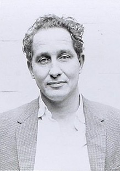
The most sensational of the escapees was Ronnie Biggs, who was sent to Wandsworth prison, which many people thought of as a U.K. version of America's notorious Alcatraz prison. Biggs was in prison for all of 15 months before he escaped down a ladder thrown over a 30-foot wall and into a waiting furniture van. He became one of the U.K.'s most wanted men but evaded capture, through a combination of cunning and plastic surgery. He went to Australia and then Brazil and lived under the name "Michael Haynes." Pursuing authorities, most notably Metropolitan Police Detective Jack Slipper, were close to capturing him twice during the next few decades, but Biggs escaped each time. He returned to the U.K. in 2001 of his volition and served the last 28 years of his sentence, this time in a jail for elderly inmates in Norwich. He died in 2013. Authorities caught most of those involved in the robbery right away. However, they were not able to identify everyone involved in the robbery. One of the most mysterious of the gang was an informant referred to as the "Ulsterman." Authorities in 2014 identified the Ulsterman as Patrick McKenna, who worked for the railroad company; however, in 2019, an investigator announced that he was clearing McKenna (who seemed an odd choice to many people because although he worked for the mail company had no knowledge of train routes or routines and, anyway, had died in 1992, leaving behind very little money), and revealing that the real identity of the mystery man was Sam Osterman, a known underworld figure who counted among his friends Tommy Wisbey, one of the men who robbed the train. As for the money that was stolen, the vast majority was never recovered. The total recovered was less than £400,000. A couple of the robbers returned their money after being caught, and some turned up later in a variety of spaces, including one large sum of £47,245 found in a public telephone box. |
|



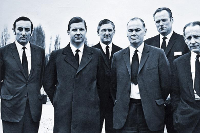 Detective Sergeant Steve Moore
Detective Sergeant Steve Moore
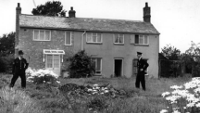 times in different vehicles and arranged for one of the gang to return and ensure that all evidence of their presence had been removed. By the time this happened, police had found the hideout and secured food, sleeping bags, bedding, bank note wrappers, and post office sacks. Police also found fingerprints on a bottle of ketchup. The fingerprints were those of Ronnie Biggs, and he was arrested on September. Also arrested within a one-week period were Roger Cordrey, Jim Hussey, Bob Welch, Charlie Wilson, and Tommy Wisbey. Joining them later was Gordon Goody who was re-arrested after being let go initially. Arrested a few months later were John Daly, Brian Fields, Roy James (caught after a chase across a series of rooftops), and John Wheater.
times in different vehicles and arranged for one of the gang to return and ensure that all evidence of their presence had been removed. By the time this happened, police had found the hideout and secured food, sleeping bags, bedding, bank note wrappers, and post office sacks. Police also found fingerprints on a bottle of ketchup. The fingerprints were those of Ronnie Biggs, and he was arrested on September. Also arrested within a one-week period were Roger Cordrey, Jim Hussey, Bob Welch, Charlie Wilson, and Tommy Wisbey. Joining them later was Gordon Goody who was re-arrested after being let go initially. Arrested a few months later were John Daly, Brian Fields, Roy James (caught after a chase across a series of rooftops), and John Wheater.
